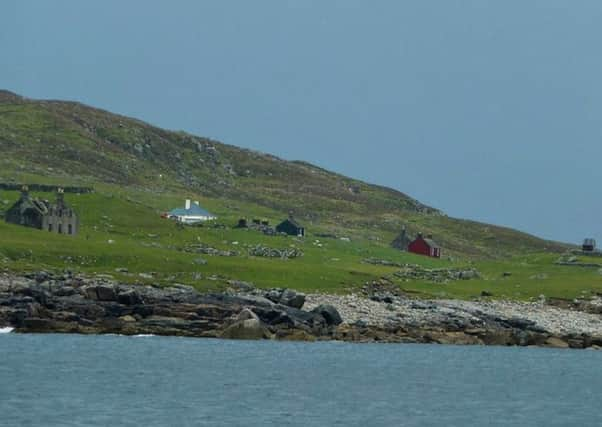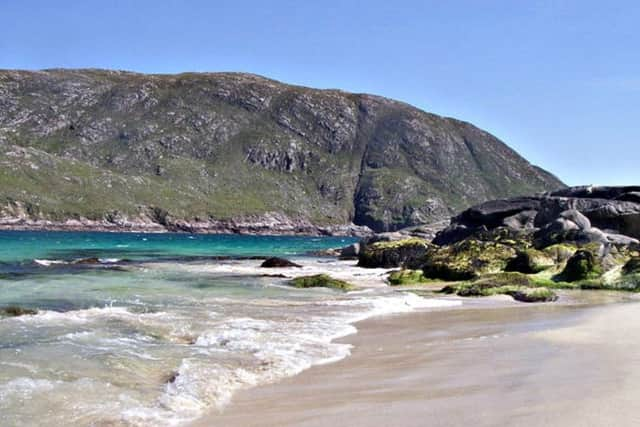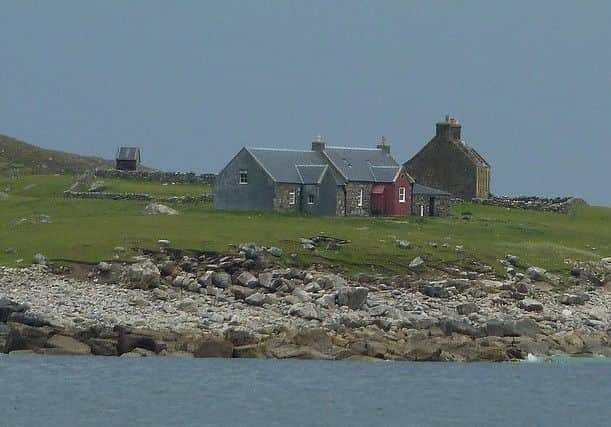When the last family abandoned the tiny island of Scarp


The departure of Mr and Mrs Angus MacInnes and their two sons on December 2 1971 marked the end of an era on the island which was home to more than 200 people in the late 19th Century.
A newspaper report documented the exit of the MacInnes family, who came ashore half-a-mile away at Hushinish Beach on Harris before settling on a croft at Govig.


Advertisement
Hide AdAdvertisement
Hide AdThe article, printed in the Press and Journal, noted how the island was then “left to the Old Etonians” given its remaining residents were Andrew Miller Mundy, whose father once owned the North Harris Estate, and his school friend Andrew Cox, who temporarily moved to the island earlier that year with his wife and their baby, India.
After the MacInnes family left, life on Scarp continued for several more weeks until a heavy storm cut the island off with provisions running ‘dangerously low’.
Mundy, in London at the time, sent a helicopter in to rescue his girlfriend, a model who he later married, with food also choppered into Scarp - just in time for Christmas.


Mundy later relocated permanently to Harris, trained himself to catch lobsters and worked the waters around St Kilda for a decade.
He became a popular figure to many, representing Harris at council level for many years and was admired for his dedication to wildlife and conservation.
Scarp, meanwhile, has seen little human life since the early 1970s.
Those who inherited the island’s crofting rights still keep sheep on Scarp with rams taken over for tupping and lambs returned to Stornoway for sale in September.


Advertisement
Hide AdAdvertisement
Hide AdThe ruins of several old buildings remain scattered over the island with a handful of holiday homes bringing in visitors from time to time.
Scarp is now owned by American musicologist Andrew Burr Bakewell, the founder of the Isle of Harris Distillery, who has had a long affection for the Hebrides.
THE SCARPACHS
Traditionally, the Scarpachs were known for their sailing and fishing skills with the islanders developing their own long oars, usually around 16ft, to keep them rowing long and hard in heavy seas a daily basis.


The oars were often placed under boats as they were pushed from the shore into the water, leaving markings in the wood. If such an oar was found washed up from the sea, it was often a fearful indication that something had gone terribly wrong on the water.
While only half a mile of shallow waters separate Scarp from Harris, the storms that ripped through the channel were enough to cut the island off for weeks at a time.
In February 1944, it was reported that the island and its 30 families went without delivery of rationed goods, mail, newspapers or food for a month after gales cut off the island.
“It is now impossible for the islanders to launch a boat when in the past fishermen would have had no hesitation in putting it to sea,” a newspaper report of the day said.
Advertisement
Hide AdAdvertisement
Hide AdThe lack of a sheltered harbour was to be an enduring challenge for the Scarpachs over generations. With no jetty, fishermen had to wade up to their waist to launch their boats each morning and remain soaked and freezing for the rest of the day.
The winter was devoted to lobster fishing, with the shellfish sent for sale at Billingsgate when possible, with the Spring spent preparing the ground for cultivation.
According to accounts, every inch of land was planted around the village with a huge variety of crops grown by islanders.
Such was the shortage of land, that youngsters had to walk to the island school via the beach so as to not to disturb the crops.
The island population peaked in 1881 when 213 people lived on Scarp with the numbers swelling following clearances on Harris.
The population was impossible to sustain with pleas made to the Napier Commission, the inquiry into conditions for crofters in the Highlands and Islands, to allow resettlement on Harris.
Despite a suggestion from a factor Kenneth Macdonald that emigration may be a better option,several Scarp families were allocated crofts in the late 1880s.
Advertisement
Hide AdAdvertisement
Hide AdAccording to research by Jill Harden for the Isle of Harris online guide, more than 25 families eked out an existence on Scarp until after World War One.
LEAVING
Population records on the Hebridean Connections website show how islanders married into families on Great Bernera, Lewis or Harris
They included Peggy Maclennan, of 13 Scarp, who married Murdo Macloed from Enaclete, Lewis, in Detroit. The Michigan state capital was a destination for many Hebrideans, particularly second-generation immigrants whose families had first settled in the eastern townships of Quebec.
The Macleods returned to Lewis with their son later born on Scarp. They had been due to return to Michigan when Peggy fell ill and died when her boy was just three years old.
Other residents included Jack Banks Ross, the son of the Scarp headmaster, who ran away to sea in 1899 aged 14 and later settled in Leith.
Meanwhile, Donald McLeod, son of Norman McLeod, of Scarp , was so strong that he once grabbed the hand of an adversary so hard that he forced the blood out his foe’s fingernails.
FAME
Scarp, although a small island, made a national impact on at least two occasions.
Advertisement
Hide AdAdvertisement
Hide AdThe trials of island life were highlighted in January 1934 when islander Christina Maclennan gave birth to her first twin, Mary, on Scarp, with the help of an untrained midwife in her eighties. Amid complications, Mrs Maclennan was taken to Harris on a boat and then, lying on the floor of a bus, moved to Stornoway to complete her labour.
Her second baby, Jessie, was delivered two days later - and 48 miles away from her sister.
The case was raised in the House of Commons by Liberal National MP Thomas Ramsay, who called for a properly trained nurse, a pier and new roads for Scarp.
That year, the island became the setting of a bizarre trial of the Western Isles Rocket Post when German scientist Gerhard Zucker arrived to test out his mail delivery system.
Said to have bee inspired by Ms Maclennan’s dramatic labour and fulled by a desire to “bring the world together” he tried to send a rocket packed with 4,000 letters over to Harris.
The mission failed with a dull explosion and a cloud of smoke - but Scarp was on the map once again.
